marketing

Ian Leman
SEO optimization of WordPress webpages
Part I: Technical Optimization
What is SEO?
Today, people make decisions largely based on information found on the Internet, so it is important that a website promoting your product or service is among the first to appear in search engines. This is done by a digital marketing practice called SEO, which means search engine optimization.
WebTailor also offers a WordPress page optimization service.
In addition to using the agency's service, it is also possible to optimize your WordPress page for Google yourself. Here are the tricks that will allow you to do this.
SEO plugins
WordPress pages by themselves are already pretty good for Google. However, it is also recommended to install an SEO plugin that allows you to better optimize the content of your website for Google. The clear winner among popular plugins is Yoast SEO – and it's free. However, Yoast SEO is not the only one, the Rank Math plugin is also widely used.
A good SEO plugin like Yoast SEO allows you to:
- Write better content thanks to page and keyword analysis;
- Change meta descriptions;
- Automatically generate XML sitemaps;
- Create breadcrumbs for page navigation;
- Add structured data (schema markup);
- Yoast SEO also offers many other optimization options. This plugin has over five million downloads and a five star rating. The plugin can be downloaded, for example, from your WordPress desktop (dashboard).
Meta descriptions indirectly affect SEO
Meta descriptions do not directly affect how often your page appears in search results, but they do affect click-through-rate (CTR). A well-written meta description can entice users to click on your page in Google results rather than the previous or next page. The higher the CTR, the more traffic and visitors you will get to your website. If users do not return to the Google search engine from your page, it gives a strong signal that they found the content of the website useful or enjoyable. This makes Google more likely to rank your pages higher in search results. Thus, meta descriptions can indirectly affect your SEO. The meta description can be added manually in the Yoast SEO plugin.
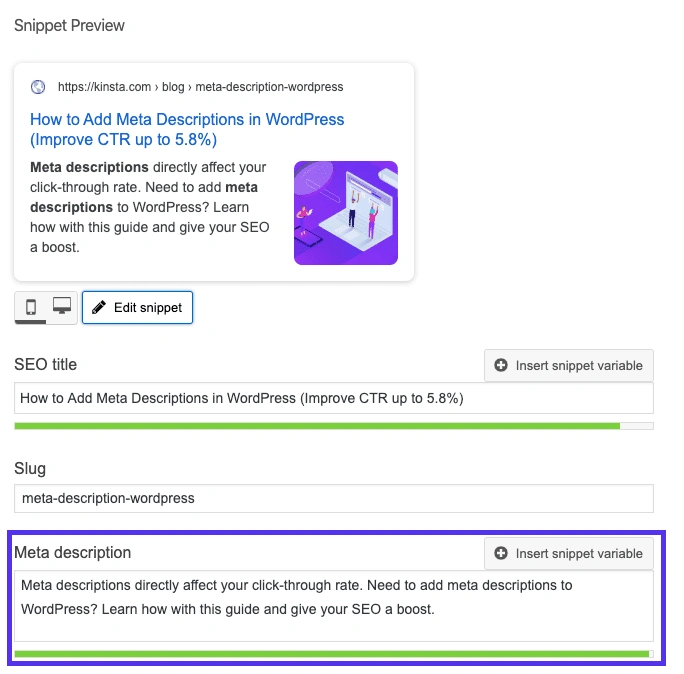
Source: https://kinsta.com/blog/wordpress-seo/#2-optimize-your-title-tags
Titles must be thoughtful
Include your main keyword in the title of your post or page. In the past, SEO experts recommended placing the keyword even at the beginning of the title if possible, as it would have more weight in search engines. At present, however, this approach is losing supporters. While adding important keywords to the beginning of your title is still important, things are now moving towards more complex scenarios where CTR optimization should be considered in addition to keyword relevance. Some people have reported a 20 percent increase in click-through rates on their page just by making minor changes to their headlines.
For example, we put the keywords “WordPress” and “SEO” in the title of this blog post not only to give our page SEO a little boost, but also to make it clear to readers what the blog post is about, thus improving our click-through rate.
How do you add a keyword to your title tags? Headlines are pixel-limited, meaning Google will only display the first 600 pixels. Many SEO plugins use character counts that are roughly in the same order of magnitude. With the Yoast SEO plugin, the title tag can be set manually, as seen below. Keep in mind that Google's display limit is about 65 characters. If you go over this, people may not be able to see your full title.
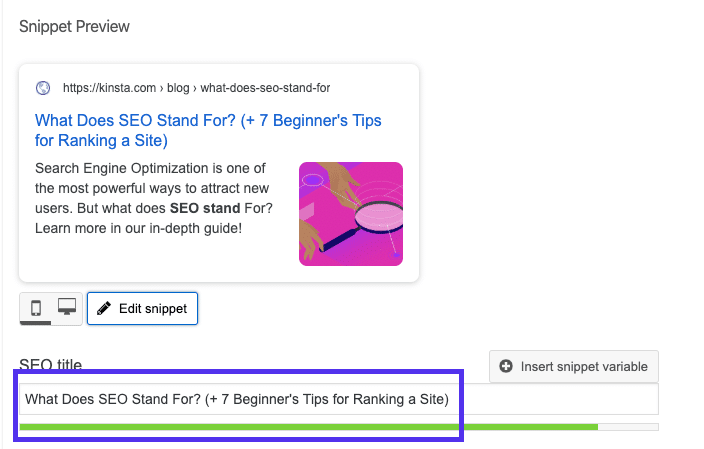 Source: https://kinsta.com/blog/wordpress-seo/#2-optimize-your-title-tags
Source: https://kinsta.com/blog/wordpress-seo/#2-optimize-your-title-tags
A/B testing headlines can be another effective way to determine clicks and help Google see your content as more relevant. There are some tools that help you to A/B test your title tags and meta descriptions.
Put simply, A/B testing is comparing your title tag or description to see which one works better for your website visitors. For example, you can test with a plugin such as Nelio A/B Testing or Google Optimize for WordPress.
Another factor to consider is whether or not to use your business name at the end of your title tags. In some cases, Google may decide to change your title tags. The most common changes involve adding a company or brand name to the end of the title. So it may not always be necessary to mention your brand name in the title. The title of the article below is “A Deep Dive Into WordPress Automatic Updates”, but as you can see, Google has added Kinsta” to the end:
 Source: https://kinsta.com/blog/wordpress-seo/#2-optimize-your-title-tags
Source: https://kinsta.com/blog/wordpress-seo/#2-optimize-your-title-tags
Volume and readability of content
There is a saying, “Content is king”. Both Google and your visitors love quality content. It is also better to publish longer than shorter content. Of course, this may vary depending on the situation. If it is a news portal, it can be the opposite, because in the case of news, it is necessary to convey the content quickly and compactly, so that the readers can quickly get the ingo. However, longer content has produced better results in the overall picture:
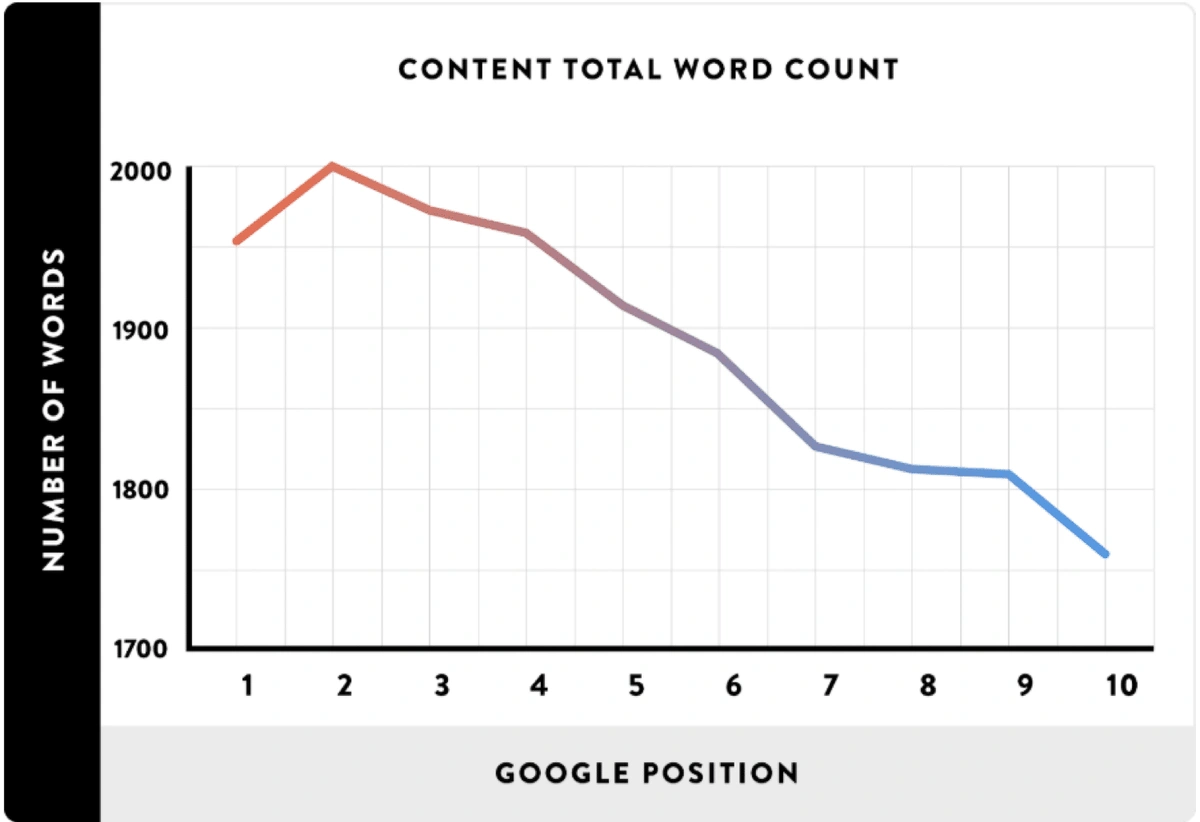
Source: https://kinsta.com/blog/wordpress-seo/#5-pay-attention-to-word-count
As you can see from the image above, the websites with the top three positions in the search results have longer content. CanIRank looked at content length and search engine ranking. They found that longer content was better, even after accounting for other possible factors. Longer content increases the likelihood that your web page will also appear in results where people use a variety of specific words and phrases in their search.
##Importance of links in SEO
Different links play a very important role in SEO. Several types of links can be distinguished:
Backlinks - links from other sites that bring the user to your page. Google uses them to assess how much authority a website has. Having a link to your website from a well-known and high-traffic website is great for your SEO. Ahrefs is a great tool to get insight into backlinks. You can see the total number of backlinks to your site, the number of referring domains, organic ranking keywords and more.
Internal links. Internal links are links of one web page itself, which connect different subpages and posts of that page. Not only are they good for SEO, but they also help with site navigation. As a result, more content is consumed and more time is also spent on the page. Internal links create information hierarchy and website structure. They help spread authority throughout your website by delivering value through links. We always recommend adding at least three to five internal links to each post or page. Depending on the length of the content, even more can be added. To add a link, you must select (highlight) the corresponding phrase or word in your content in the text editor and add a link to it by clicking on the corresponding icon:

Source: https://kinsta.com/blog/wordpress-seo/#11-create-an-internal-linking-strategy
- Anchor links. You've probably come across anchor links when reading long blog posts. These links allow you to jump to different parts of the post. Anchor links are great for improving user experience because they allow readers to quickly find the information they need. In the case of a long post, this also helps to avoid excessive scrolling. This article will help you add anchor links.
Having an XML sitemap is recommended
Search engines like Google, Bing and Yandex use XML sitemaps to understand the hierarchy and structure of your WordPress site. The XML sitemap contains all the links on the web page. Content maps are optional, but creating them allows access to more site reporting data. Therefore, we always recommend using an XML content map. This gives search engines a clear picture of the structure of your web page.
The Yoast SEO plugin can automatically generate content maps. Follow the steps below to enable or confirm this feature:
Step 1: Turn on the XML content map setting
On your WordPress desktop, go to SEO > General. Make sure “XML sitemaps” is turned on:
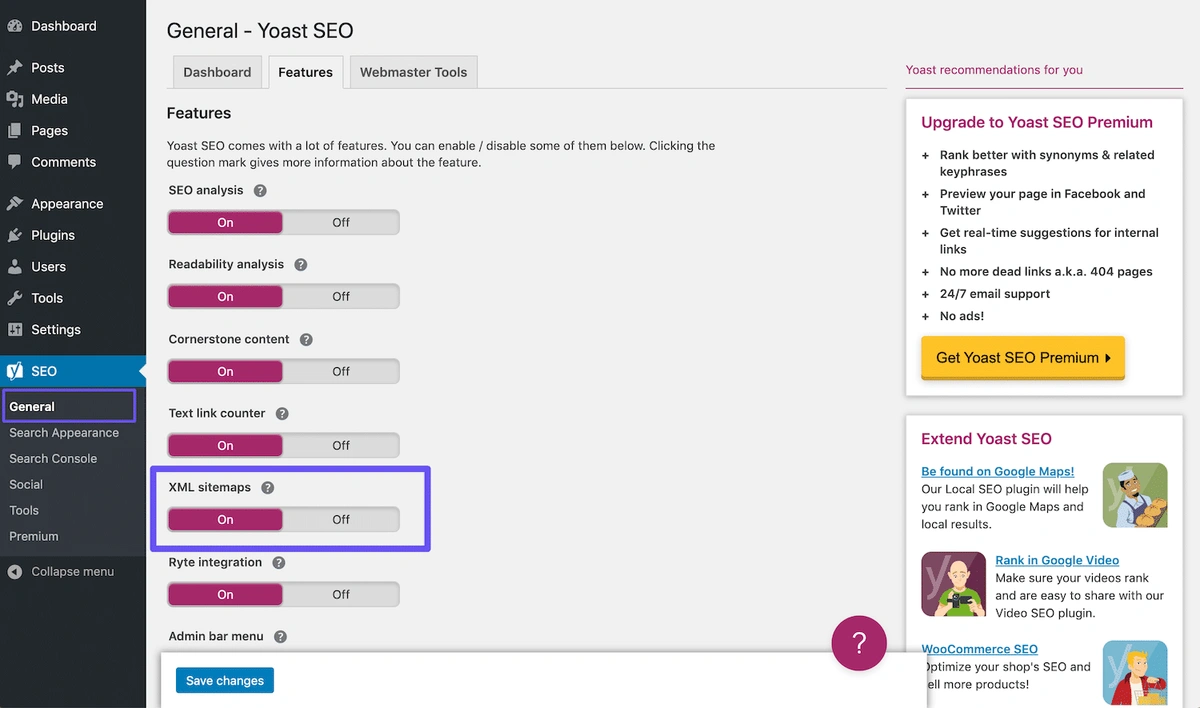
Source: https://kinsta.com/blog/wordpress-seo/#20-set-up-an-xml-sitemap
Step 2: test your sitemap
It is always wise to double check that the files have indeed been created successfully. You can view the sitemap index by adding sitemap_index.xml to your domain, for example like this:
https://domain.com/sitemap_index.xml
The result should look something like the image below:
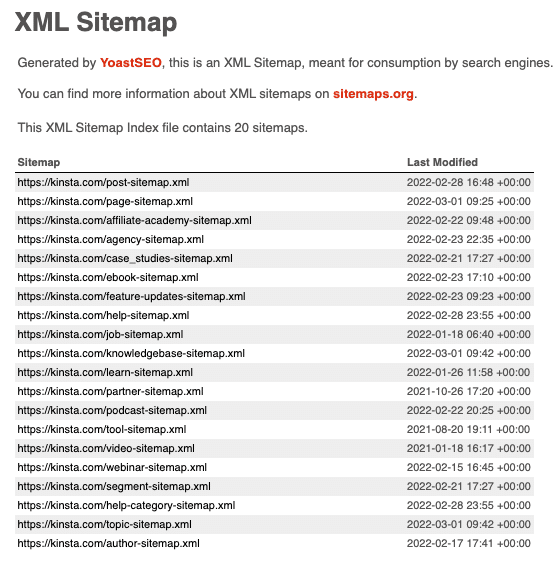
Source: https://kinsta.com/blog/wordpress-seo/#20-set-up-an-xml-sitemap
Crawlers - avoid errors and make sure they can edit your page
Google has text-reading robots (crawlers) that don't read or see an image like humans, but read what's tagged for them. If crawlers are prevented from reaching your page or they cannot read the text on the page correctly, your page will also fall down in the search results. This can happen for a number of reasons, from broken links caused by improperly setting up links or removing content without redirects, to server errors where your server could not respond to a request from crawlers. A great way to check for errors is to go to your Google Search Console account. There you will find a report detailing all the errors that Google has found on your site during the crawlers' work.
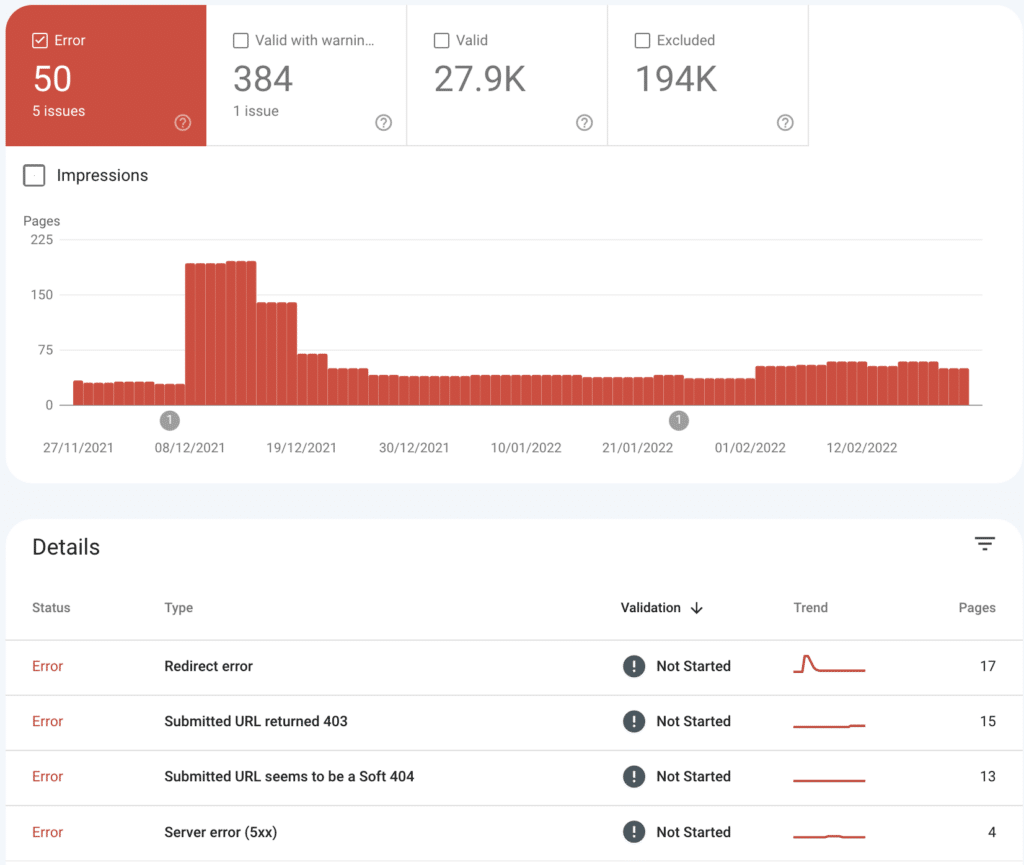
Source: https://kinsta.com/blog/wordpress-seo/#25-check-for-crawl-errors
Clicking on any error type will take you to some examples of bad URLs. Then you can get more information by clicking on the check URL icon. This shows how Google discovered the URL.
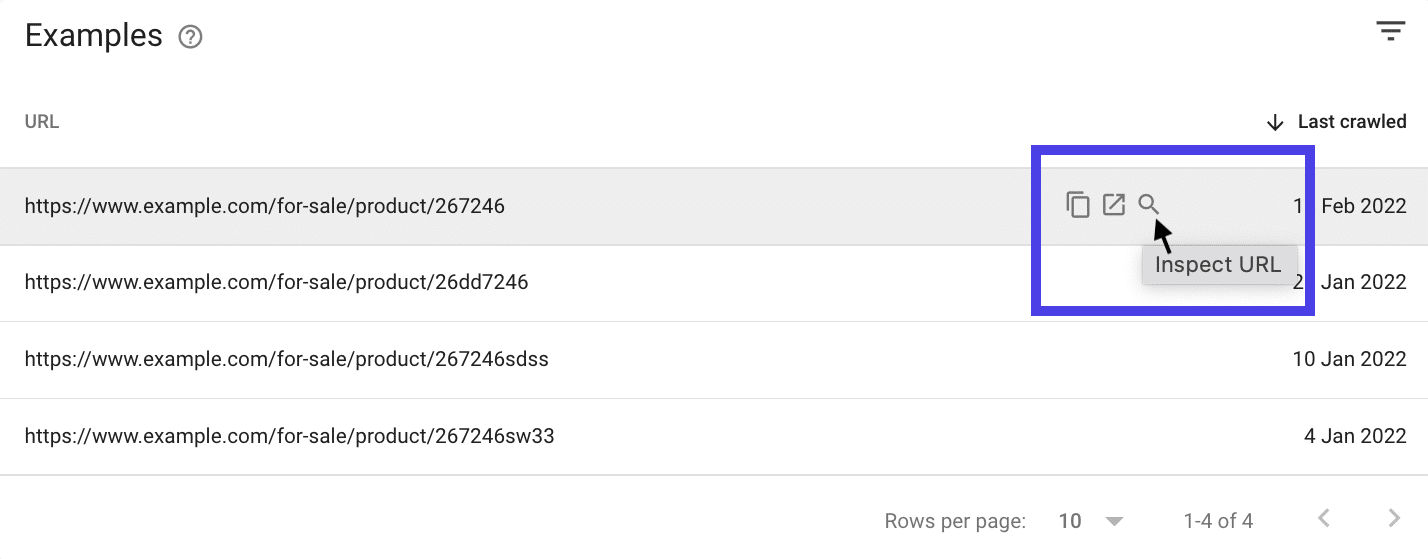
Source: https://kinsta.com/blog/wordpress-seo/#25-check-for-crawl-errors
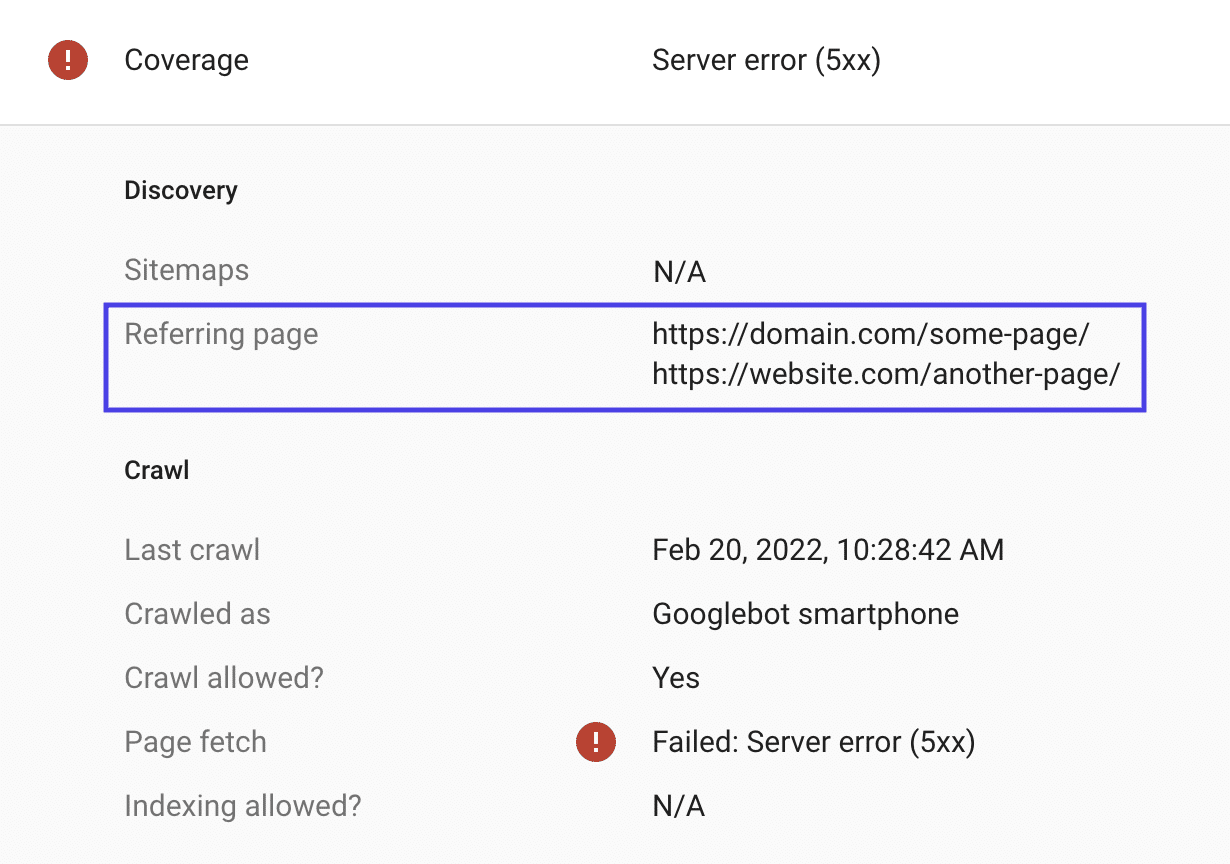 Source: https://kinsta.com/blog/wordpress-seo/#25-check-for-crawl-errors
Source: https://kinsta.com/blog/wordpress-seo/#25-check-for-crawl-errors
You can now contact the website with the broken link and request to update it, or if the link is from your page, update it yourself. Another option is to add a 301 redirect from the broken URL to the correct URL. Google Search Console also has another useful tool that highlights other errors found by the crawlers. Click on “Settings” in the left menu, then click “Open report” in the “Crawling” section:
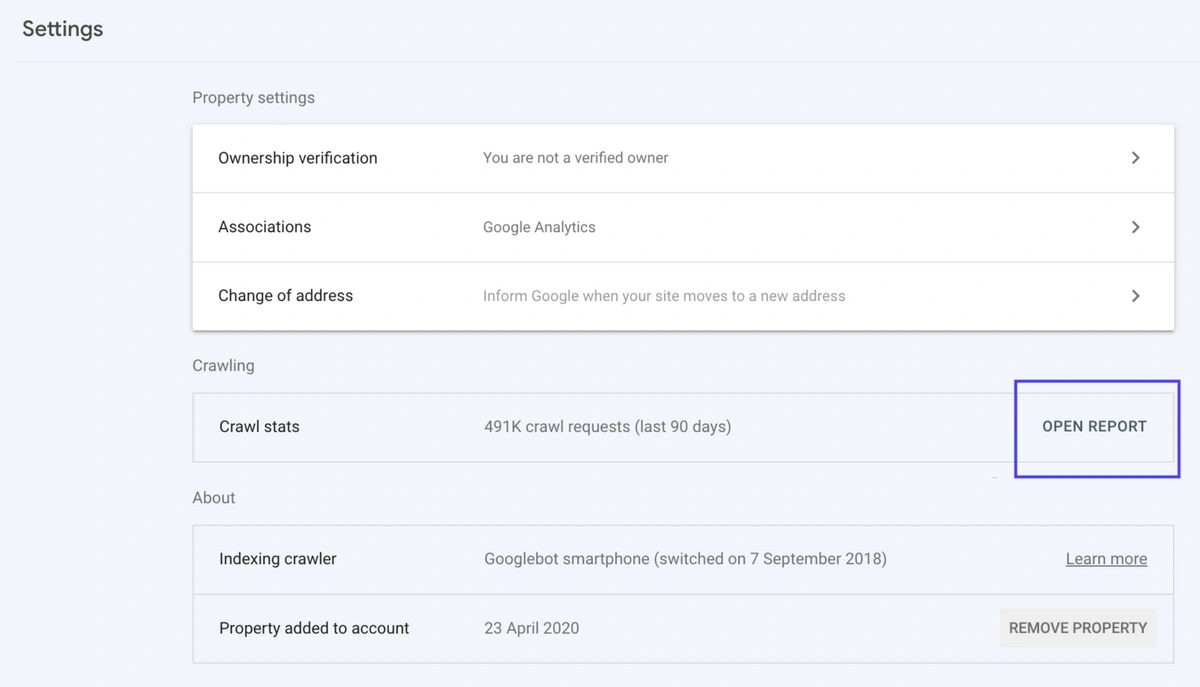
Source: https://kinsta.com/blog/wordpress-seo/#33-optimize-your-websites-speed
See the “By Response” section for more information on error types:
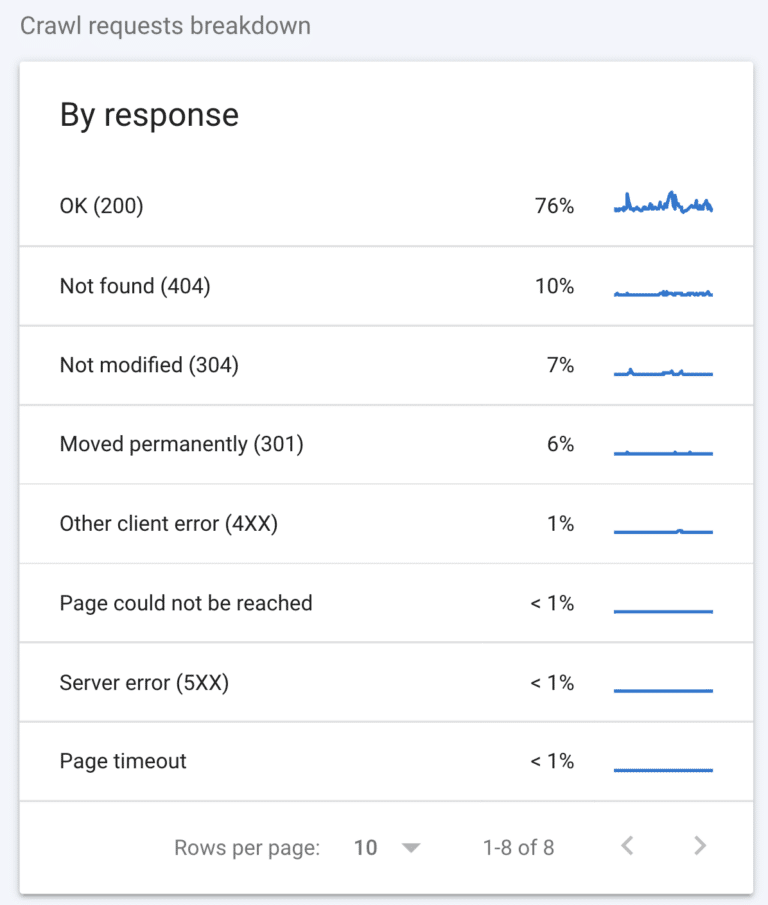 Source: https://kinsta.com/blog/wordpress-seo/#25-check-for-crawl-errors
Source: https://kinsta.com/blog/wordpress-seo/#25-check-for-crawl-errors
If Google's bots can't work on your page, the pages won't be ranked, which means they won't appear in search results. Fortunately, Google's Search Console URL Checker tool can once again help you out. This allows you to check if crawlers were able to visit and rate your page. It contains, among other things, information about how the URL was first discovered by Google and when it was last visited by crawlers. To check the page, enter the URL in the search box at the top of the page.
Structured data
You may have heard the terms "structured data" or "schema markup". Structured data is additional code that helps search engines deliver more and better data to visitors. When you see a star rating next to a review in Google search results, you're also seeing structured data results. This can help you achieve special places in search engine results, which in turn can increase the click-through rate of your page.
The CXL Institute conducted a study and they found that companies that used star ratings experienced significantly higher click-through rates from organic search results, up to 35 percent. They concluded that this strategy produces good results.
Another important reason to use structured data is that it can help Google better understand what your business is about. This can increase your brand search click-through rate and allow your website to be featured in other search results. Many WordPress themes have schema markup, but some do not. You can test your website or post with Google Structured Data Testing Tool:
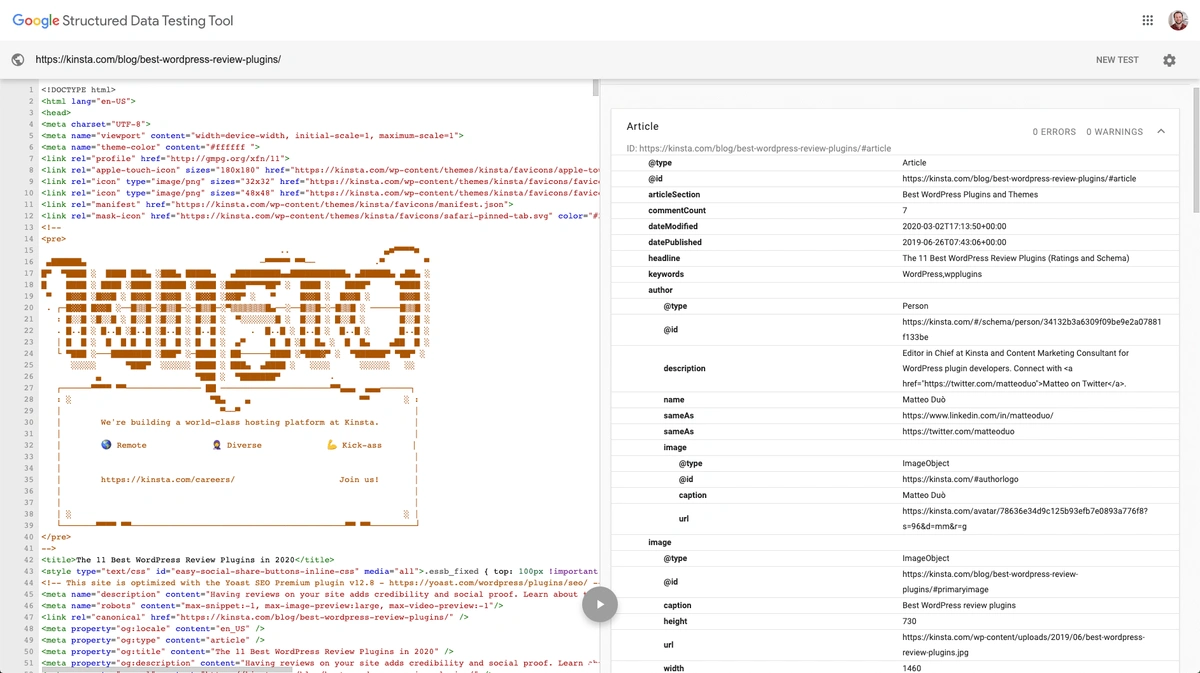
Source: https://kinsta.com/blog/wordpress-seo/#28-use-structured-data
If the result is good, you will see different information on the right side and no errors. However, if the right section is empty, it means that your WordPress page has no schema markup.
Yoast SEO has some structured data built in. In the WordPress admin menu, click the SEO button Appearance. Enter the name of your organization and upload a logo. Once you've saved your changes, you'll have an organization chart set up that should be visible in the Google Structured Data Testing Tool. Yoast SEO also adds structured data to your pages, meaning all blog posts should appear with schema markup.
If you want to add another schema markup to your WordPress site, we recommend using the Schema plugin. It will automatically add the necessary code. You can then run a new test with the Google Structured Data Testing Tool.
SEO audits
A great way to instantly check how well your WordPress site is optimized is to do a quick SEO audit. There are great free and premium tools for this. For example, SeoSiteCheckup is a free tool that lets you know how a website is doing. Other SEO tools, including Ahrefs and Semrush, allow you to schedule weekly audits to help quickly identify any issues that may arise with SEO.
Remove duplicates (pages, content, etc.)
Duplication of the same content happens more often than you think. Unfortunately, having multiple copies of your content can cause serious SEO problems. While Google won't directly penalize you for posts or pages that appear twice, it can affect your page's position in search results.
The main problem is that when Google finds two pages or posts with identical content, Google doesn't know how to rank them. Hypothetically, this means that, for example, a tab located on your private server that is identical to a public page may appear in Google search results instead of a public page. In this case, the easiest way to solve the problem is to prevent search engines from indexing the site. WordPress allows you to do this quickly. Go to Settings > Reading and check the option “Discourage search engines from indexing this site”:
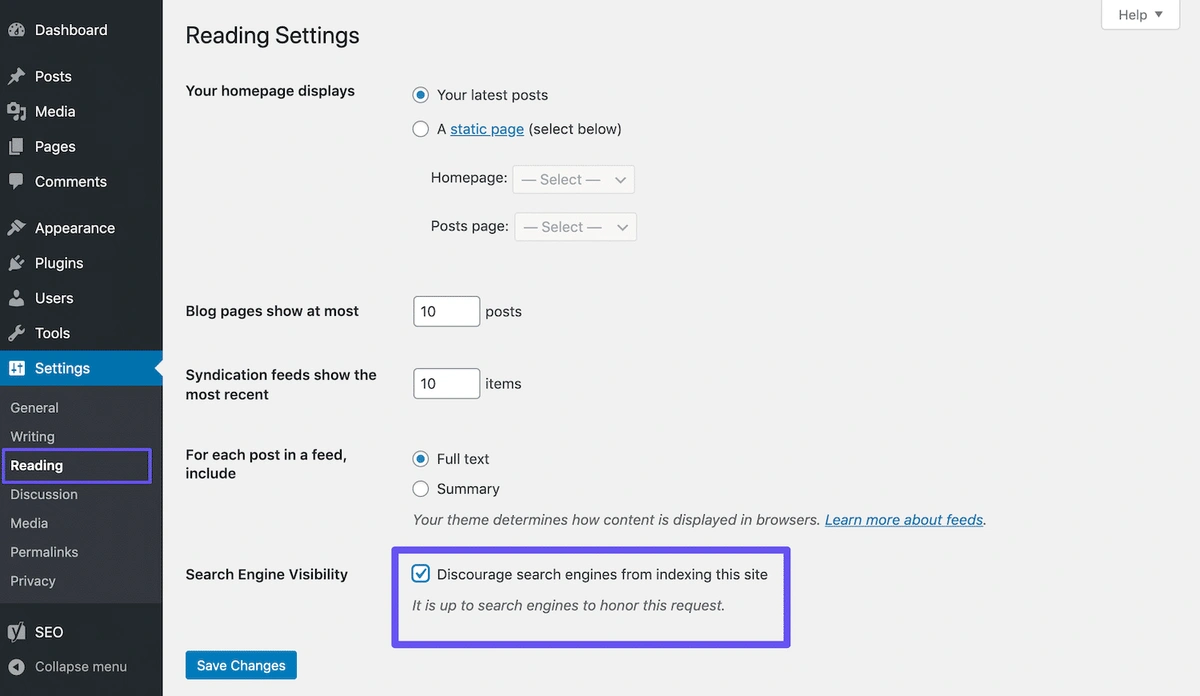 Source: https://kinsta.com/blog/wordpress-seo/#30-deindex-duplicate-content
Source: https://kinsta.com/blog/wordpress-seo/#30-deindex-duplicate-content
Page speed is crucial
Website speed is an extremely important factor in the SEO of WordPress pages. Google already stated in 2010 that speed affects page ranking. In addition to Google, page speed is also important to your visitors. Here are some examples of statistics that prove it:
- One in four visitors will leave a website if it takes more than four seconds to load. 46% of users do not visit a page a second time if they know from first experience that the page is slow.
- Website owners have just five seconds to capture the attention of visitors before they consider leaving.
- 74% of users visiting a website on mobile will leave if the page takes longer than five seconds to load.
Every secondary delay in page loading can also cost big players like Amazon $1.6 billion in annual losses. You can quickly improve your site speed by implementing a CDN, using a fast theme, and optimizing your site effectively. But these strategies only help to a certain extent. Your web host plays a significant role in the speed of your site, so it's important to invest in a quality web hosting provider.
Short URLs are better
Google likes organized and well-structured sites, so it is recommended to use short URLs on your website. They can also help improve your click-through rate. MarketingSherpa conducted a study and found that people in executive positions are 250 percent more likely to click on an organic listing when:
- is a relatively short URL
- appeared directly below the entry with the long URL.
Therefore, keeping URLs as short as possible can be a big competitive advantage. Remember that WordPress will automatically generate a URL for your posts based on their titles.
To shorten the URL of a WordPress post or page, you need to find the permalink setting. In both the classic and block editors, you'll find a setting that allows you to edit your post's "slug," the part of the URL that appears after the last slash (/). In the classic editor, it is displayed directly under the post title:
 Source: https://kinsta.com/blog/wordpress-seo/#36-use-short-urls
Source: https://kinsta.com/blog/wordpress-seo/#36-use-short-urls
Click the “edit” button to change the slug. Remember to separate words with hyphens. Additionally, every post and page on your site must have a unique URL. If you create a URL that already exists, WordPress will automatically append a hyphen and a “1” to the end of your slug. When creating a third URL of the same type, a hyphen and “2” etc. are added accordingly. In the block-type editor, you can find this option in the right sidebar:
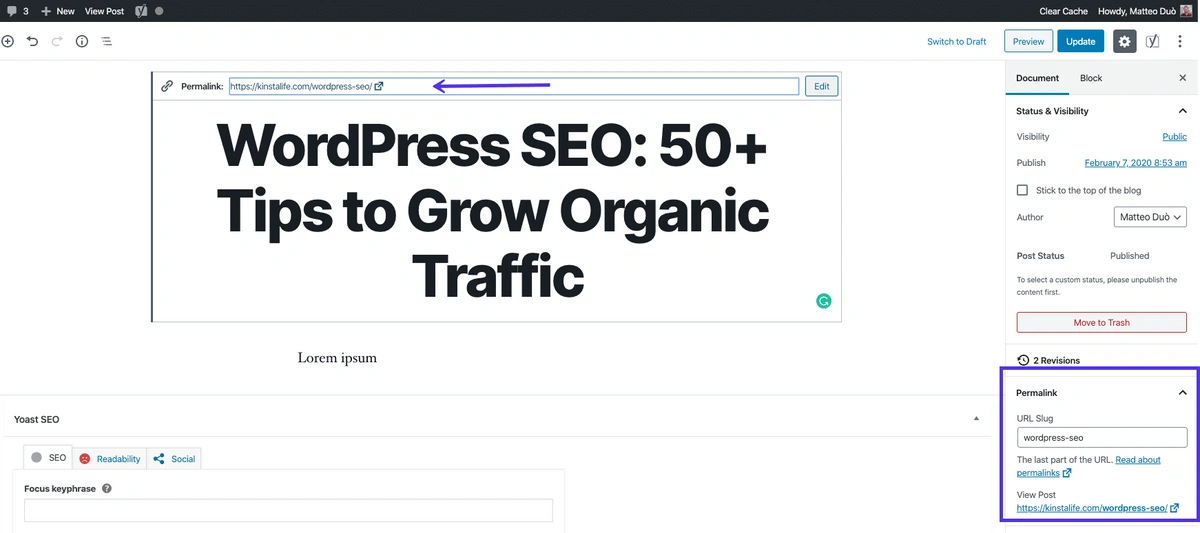 Source: https://kinsta.com/blog/wordpress-seo/#36-use-short-urls
Source: https://kinsta.com/blog/wordpress-seo/#36-use-short-urls
Photos
Regarding images, it is important that they are of high quality, of optimal size, and that the file names of the images are appropriate. In addition, the presence of alt-text is good. Here are some tricks related to image file names:
-Images should always be given an appropriate file name related to the content. For example, instead of DC0000.jpg, wordpress-seo.jpg is much better if the assumed image is, for example, a schematic about WordPress SEO.
- Always use hyphens to separate words in a file name, not underscores or hyphenation. For example, if you name the file wordpress_seo.jpg or wordpressseo.jpg, Google will not be able to read it. It only reads hyphenated files containing single words, so it's best to name the image wordpress-seo.jpg.
- Include a keyword in the file name if applicable. It is recommended that the keyword be included in the featured image file name of the page or post.
- Make sure that the file names of the images are all in lowercase letters. This way, you can maintain a clean and consistent style across all URLs on your site. 2
It is important to use alt-text. Alt-text is an alternative text displayed instead of an image, if, for example, the image should not be downloaded for some reason. You can easily insert it by selecting an image from your Media Library and adding an alt-text to it in the settings: 2
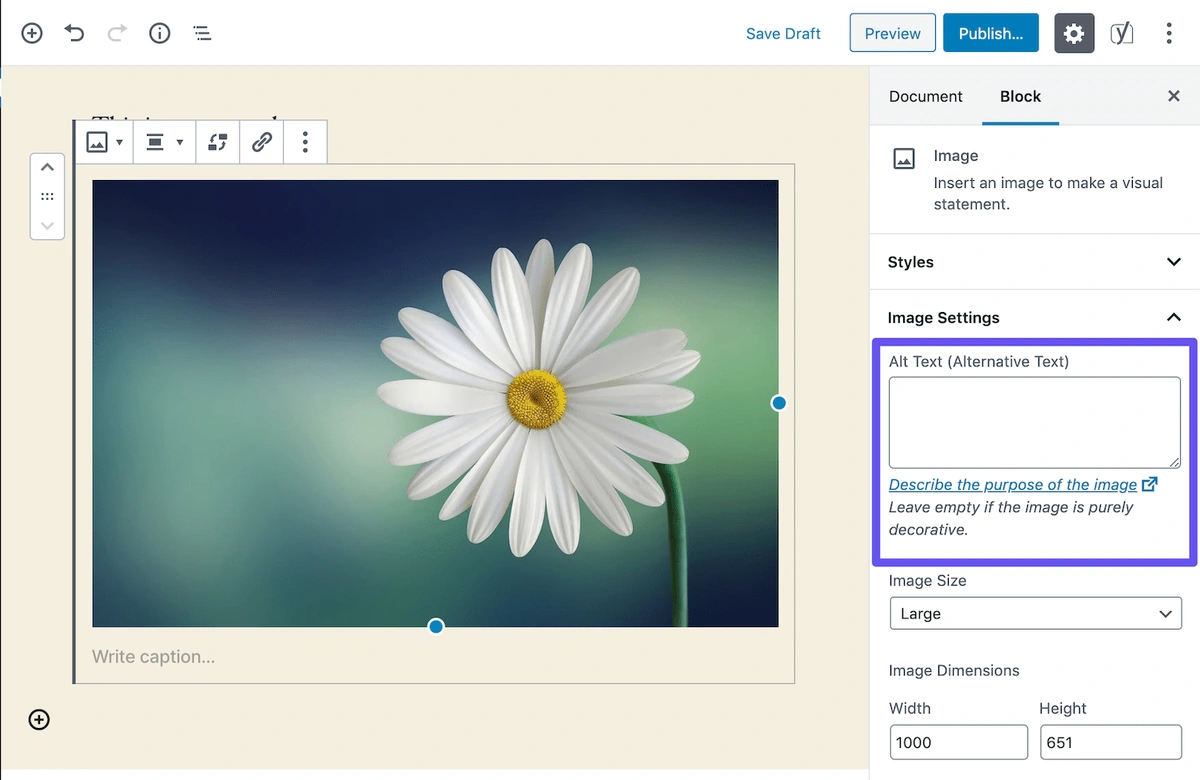 Source: https://kinsta.com/blog/wordpress-seo/#50-add-alt-text-to-your-images
Source: https://kinsta.com/blog/wordpress-seo/#50-add-alt-text-to-your-images
Also, when adding a new image to a WordPress site, it is possible to give the image an alt-text in the above way right from the start.
Part II: Content Optimization
Search for important keywords, i.e. do keyword research
Keywords in titles, body text and elsewhere are important. Therefore, it is important to have an overview of the ranking of keywords relevant to your company. Google's algorithm ranks keywords based on how popular they are. In other words, Google values keywords that people use frequently when searching. Here's an example of a brand new website that went from 0 to 260,000+ monthly visits with just less than 30 articles because they used just the right keywords:
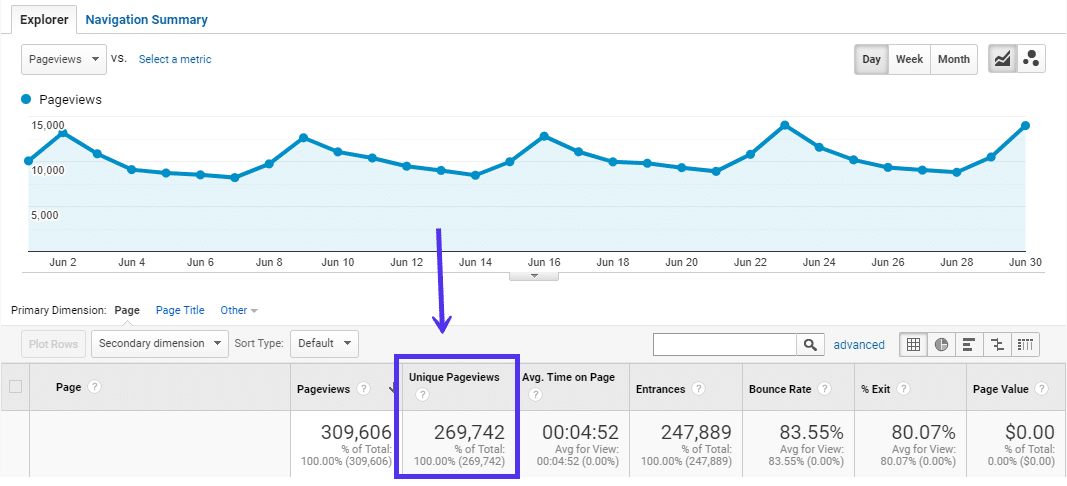
Source: https://kinsta.com/blog/wordpress-seo/#39-do-keyword-research
How did they do it? They found their niche and did strategic keyword research. There are many great tools that make this possible. Some of them are SEMrush, Ahrefs and KWFinder. The goal is to find a good keyword that is used a lot or has a high volume. It is also important to do keyword research for other languages if your page has been translated into multiple languages. It is important to remember that some keywords may not be widely used in one language, but may be used in other languages.
Always use the main keyword, especially in the first paragraph
You have to write content for your visitors and customers, but you have to be smart and use the main keyword in the right place. The best place to use your main keyword is at the beginning of your page or post: the introduction and/or the first paragraph. Every time you write a blog post on your WordPress site or create new content for a page, you should use the appropriate keyword in the text. It is necessary to consider whether the content of the post or page allows the use of the keyword in an appropriate context. Don't create a new post or subpage just to publish more content.
With the Yoast SEO plugin, you can easily determine the keyword you want to write about. For this example, the keyword "WordPress SEO" was used. You can see that Yoast SEO analyzes the frequency of occurrence of the keyword and reports that it is a bit low for this post:
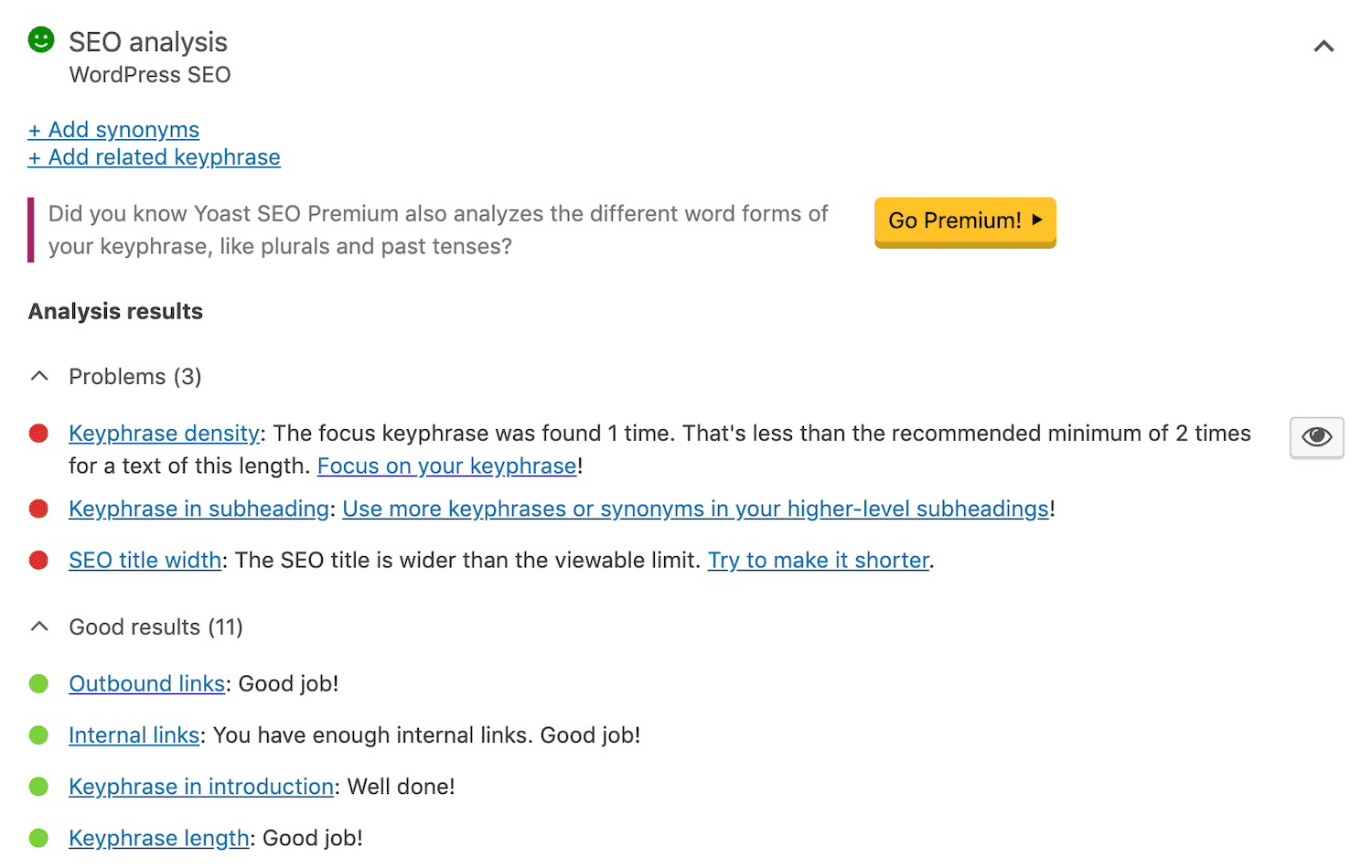
Source: https://kinsta.com/blog/wordpress-seo/#40-always-use-a-focus-keyword
The first paragraph of any post or page is the most important. This is because Google scans content from top to bottom, and if it finds your keyword quickly, it is more likely to find your content relevant and useful. It is also necessary to "tune" the readers right from the beginning, so that they know that the following paragraphs contain exactly the content that they expected.
The Yoast SEO plugin helps to ensure that the main keyword is used at the beginning of the post or other text:
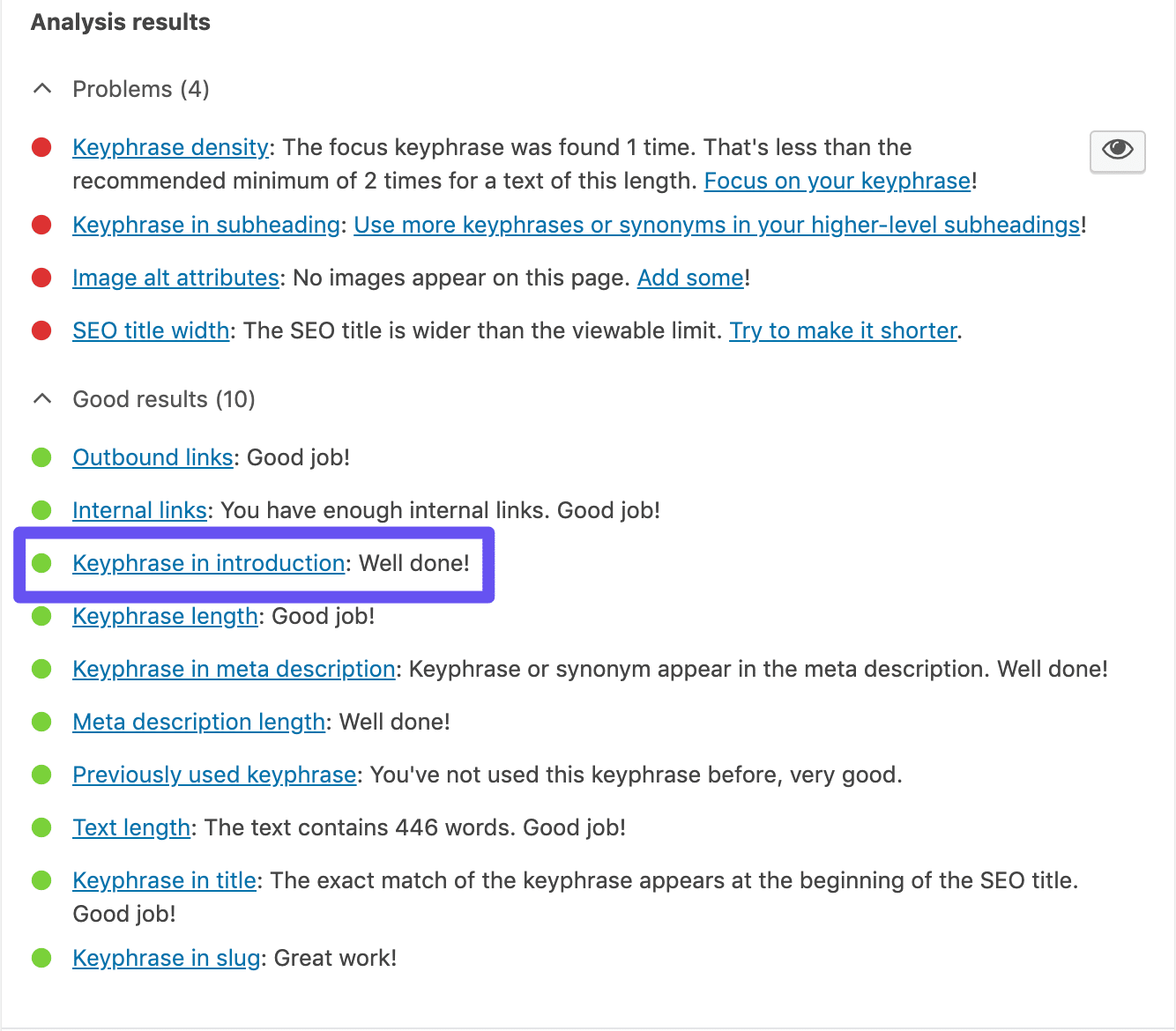
Source: https://kinsta.com/blog/wordpress-seo/#41-include-your-focus-keyword-in-the-first-paragraph
Make sure that pages or posts are not fighting for one keyword
Keyword cannibalization means a situation where two or more subpages of a website compete for the same keyword. In the example below, yoast.com is represented in Google search results with two of its own pages. However, if you combine these two pages into one post in terms of content, it may have a higher potential to appear first in search results:
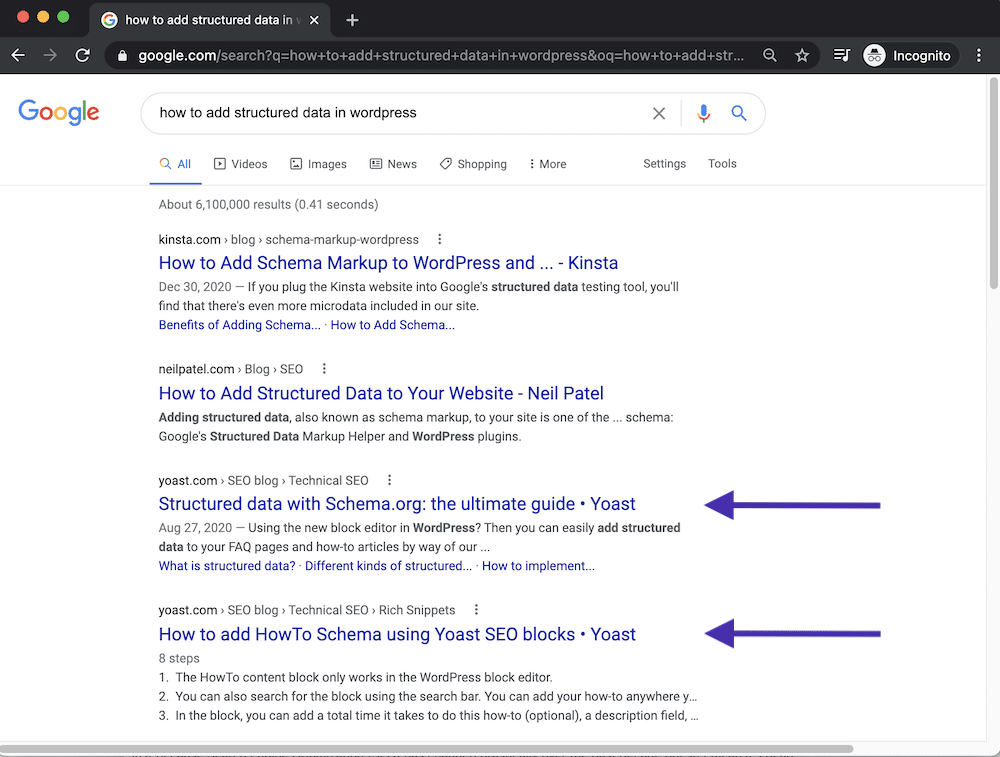 Source: https://kinsta.com/blog/wordpress-seo/#42-avoid-keyword-cannibalization
Source: https://kinsta.com/blog/wordpress-seo/#42-avoid-keyword-cannibalization
There are several ways to check if keyword cannibalization is occurring on your page. A tool like Ahrefs allows you to track this. In this example, you can see how the results are not stable due to keyword cannibalization:
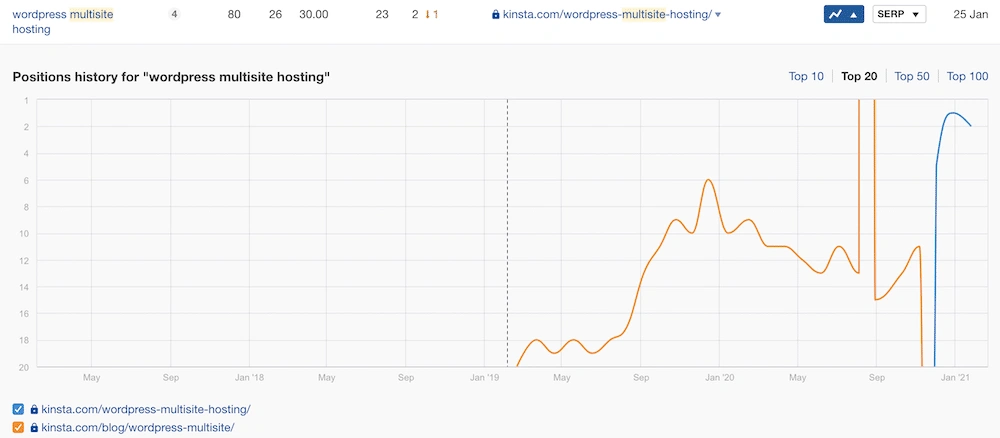 Source: https://kinsta.com/blog/wordpress-seo/#42-avoid-keyword-cannibalization
Source: https://kinsta.com/blog/wordpress-seo/#42-avoid-keyword-cannibalization
Try to get your page in Google's featured snippet
Have you ever seen a box appear at the top of Google search results in the form of a list, table or paragraph, often accompanied by one or more images? This is featured content and can help your page jump to the top, zero position in Google search results.
Here is an example of featured content:
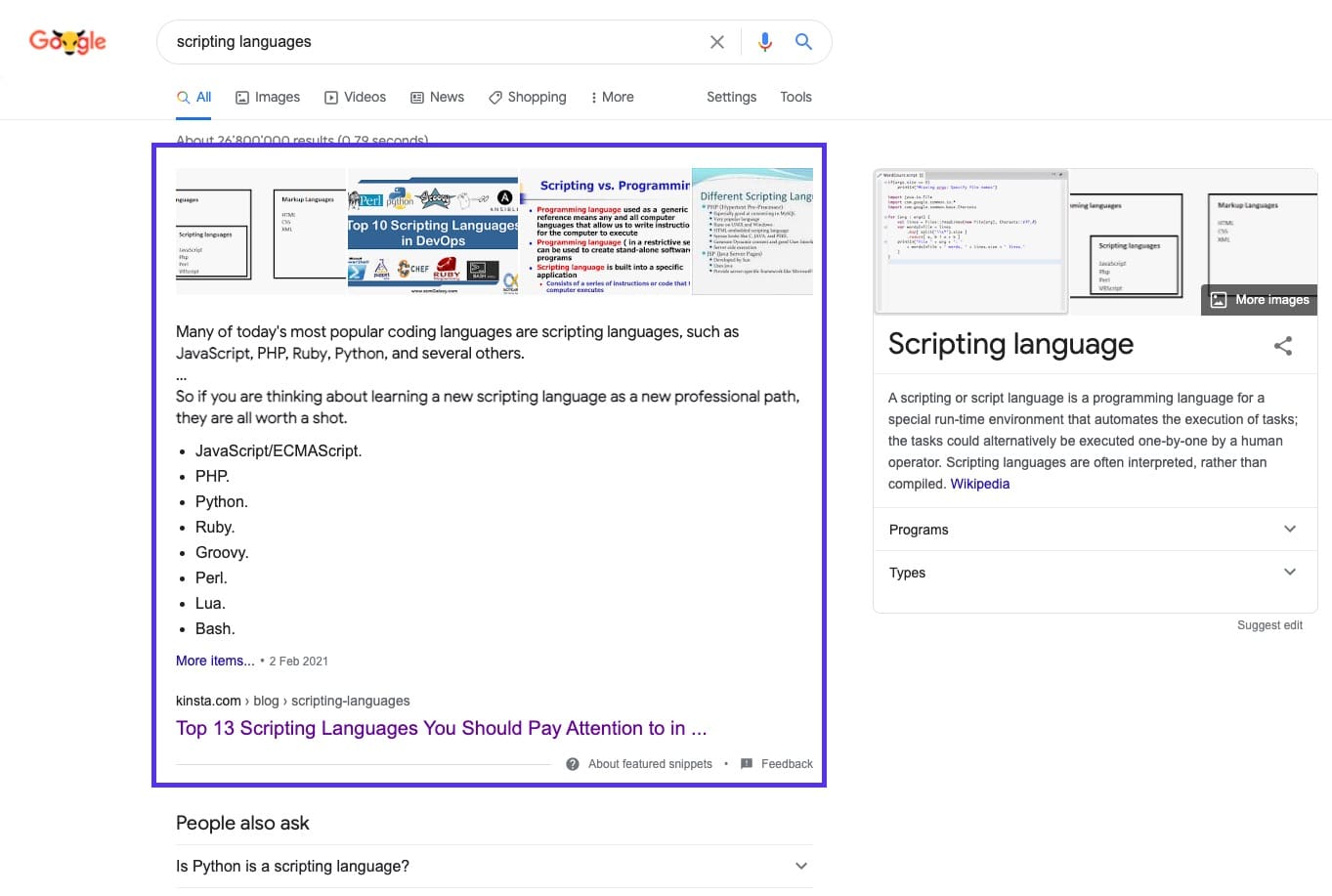 Source: https://kinsta.com/blog/wordpress-seo/#47-get-your-content-into-google-featured-snippets
Source: https://kinsta.com/blog/wordpress-seo/#47-get-your-content-into-google-featured-snippets
Featured content takes up more space than a traditional blue link and description. This can increase the number of clicks on your page. If the content of your page has been promoted in Google yesterday, it will have a good effect on the increase in the number of visitors to the website. Unfortunately, there is no magic recipe for getting your page featured. However, based on personal experience, it has been found that the following steps can help:
- Add schema markup to help Google understand what your content is about and how it fits into your website;
- Use heading tags (
–
), bulleted lists and numbered lists effectively;
- Keep your paragraphs short – featured content is usually around 40-50 words;
- Use questions as titles and answer them in the body text (questions and answers are often a form of featured content on Google);
- Use high-quality images and videos.
If you follow these tips, you should be on the right track.
Optimize your content for Google Discover
Google Discover is a content recommendation service for Android. It's a stream of content that Google thinks users will find relevant based on their search history and other content they've consumed. Mobile usage is constantly growing, so optimizing your posts for this platform can only help you. Because Google Discover isn't search-based, keyword research and optimization won't help you get your posts into users' feeds. However, there are several actionable steps you can take to remedy the situation, such as:
- Create quality content;
- Choose a good title (clickbait can work well here);
- Use images and videos in your posts (an image 1200 pixels wide is optimal, avoid using a logo);
- Mix different content types and try different styles like lists, questions and answers, popular topics. Create content of constant value over time and consistently add new posts;
- Link your site to social media accounts;
- Translate your content;
- Have a mobile friendly site.
When it comes to images included in your posts, you may also want to consider enabling large images in Google Discover. Statistics show that it increases CTR, time on page and user satisfaction. To use large images, you must join the Google program using this form.
Connect your page to social media accounts and be active on social media
It makes sense to add social media accounts to your page as soon as possible. Typically, businesses should do this as soon as the website is set up and accessible to guests. Most social media backlinks do not contribute to SEO, but can still bring more visitors to your page.
In addition, it is good to know that your business-related activities on the Internet outside of your WordPress page can affect SEO to some extent. Tweets, shares, Reddit upvotes, and other such activity on other sites can temporarily affect your page's position in search results. All kinds of sharing, social signals, and the larger flow of information outside of the page affect the position of the page in search results in one way or another. Broadcasting content on various social media channels and subsequent secondary activity (for example, sharing) will bring information about your company to more and more people. This, in turn, leads to new links and clicks as people start referring to your content from different platforms. Therefore, we recommend using social media as much as possible and making well-thought-out marketing campaigns on relevant platforms for the company.
Local SEO
Local SEO means optimizing a page so that it gains visibility in the local search results of a region. This includes, for example, adding a business profile to Google and creating content appropriate for a specific location. Local SEO is especially important for small businesses. A good step is to register your company in Google Business Profile and Bing Places. These are free tools that help increase the visibility of your business when someone searches for services based on location (for example, coffee shops in their vicinity).
Translate the page and add new languages if necessary
Making your page multilingual can have a significant impact on WordPress SEO and can also significantly drive new visitors to your page. Neil Patel experimented and saw a 47% increase in traffic to his site after he translated his page into the 82s language. However, it is worth remembering that this does not work in all cases, and success depends on the specific company and geographical location. Still, it's something to think about.
When it comes to implementing different languages on your WordPress website, Google will not “penalize” you for duplicate content, but you must have the correct hreflang and canonical tags. In the example below, the tags highlight the URL for the English version of the page, but also indicate the presence of a Spanish version. This helps search engines understand which version of the page is most appropriate for the user based on the language settings of the user's browser. Also visible is the "x-default" hreflang attribute, which indicates which version should be used if no translated version is available for the user.
English version:
 Source: https://kinsta.com/blog/wordpress-seo/#59-translate-your-website
Source: https://kinsta.com/blog/wordpress-seo/#59-translate-your-website
Plugins can be used to translate WordPress content, such as Weglot. However, no automatic translation tool beats a professional translator. Therefore, if possible, it is recommended to hire a professional translator or someone who is a native speaker of the target language.
Track Google Analytics metrics and keyword rankings
A very good way to monitor the SEO situation of a WordPress page is to create a user in Google Analytics. Then, the first thing to do is link your Google Analytics account to your Google Search Console account:
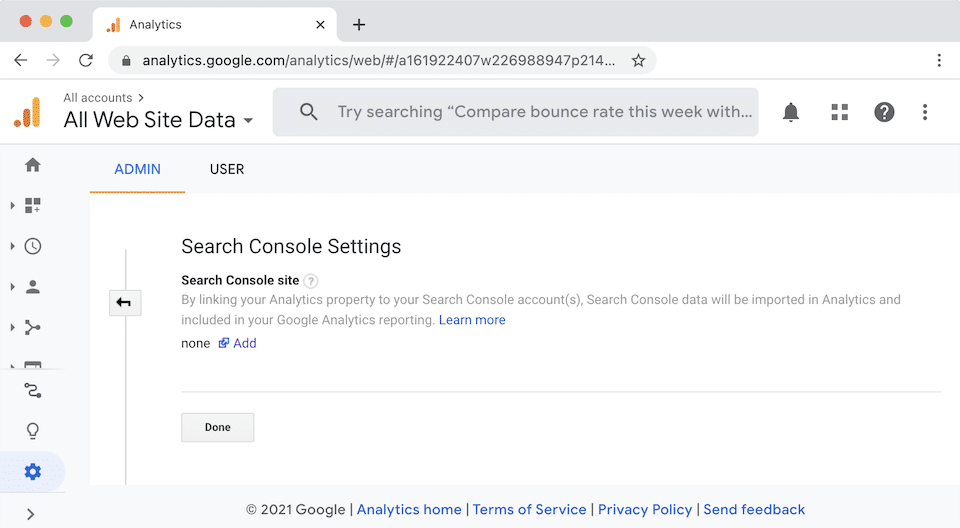
Source: https://kinsta.com/blog/wordpress-seo/#60-keep-an-eye-on-google-analytics
This adds an additional section to your Google Analytics account that lets you view search queries, top content pages, and more:
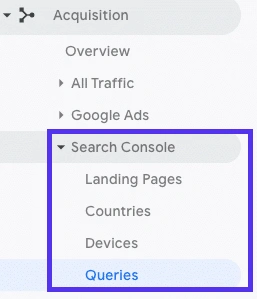 Source: https://kinsta.com/blog/wordpress-seo/#60-keep-an-eye-on-google-analytics
Source: https://kinsta.com/blog/wordpress-seo/#60-keep-an-eye-on-google-analytics
Summary
There are several ways to optimize the SEO of a WordPress page, but in general, it is useful to have a well-structured page, apply relevant plugins, add images with appropriate attributes and different types of links, and put the various tools provided by Google to work in your favor.
Used sources:
https://blog.styla.com/en/22-seo-techniques https://kinsta.com/blog/wordpress-seo/ https://kodulehekoolitused.ee/ab-testimine-kuidas-testida-wordpressis/ https://confluence.ttu.ee/taltech-web-manage/kodulehe-optimeerimine-seo
Ask for a free SEO report and competitive analysis!
